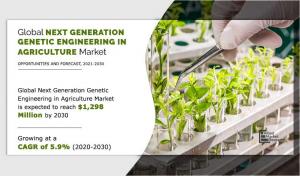Next-Generation Genetic Engineering in Agriculture Market : Size, Growth Drivers, and Industry Analysis 2021-2030
The global next-generation genetic engineering in agriculture market is projected to reach $1,298 million by 2030, registering a CAGR of 5.9% from 2021 to 2030.
WILMINGTON, DELAWARE , UNITED STATES, June 13, 2024 /EINPresswire.com/ -- According to a new report published by Allied Market Research, titled, “Next-Generation Genetic Engineering in Agriculture Market By Objective, Application, and Trait: Global Opportunity Analysis And Industry Forecast, 2021–2030," the global next-generation genetic engineering in agriculture market size was valued at $756 million in 2020, and is projected to reach $1,298 million by 2030, registering a CAGR of 5.9% from 2021 to 2030.
The process of changing a crop's genetic makeup using recombinant DNA (rDNA) technology is known as "next-generation genetic engineering." Through this process, a DNA sequence is incorporated into plant cells, genetically altering the crops. One of the conventional methods of plant breeding involved crossing plants with significant features. Conversely, the plants of the wild type provide lower-quality harvests. This necessitated genetically altering the crops using next-generation genetic engineering. Next-generation genetic engineering in crops has several benefits, such as lower costs for producing food or drugs, increased crop yields, less need for pesticides, and improved nutrient content and food quality.
𝐑𝐞𝐪𝐮𝐞𝐬𝐭 𝐒𝐚𝐦𝐩𝐥𝐞 𝐂𝐨𝐩𝐲 𝐨𝐟 𝐑𝐞𝐩𝐨𝐫𝐭 https://www.alliedmarketresearch.com/request-sample/A12370
The global market for next-generation genetic engineering in agriculture is expanding due to factors such as increased demand for fruits and vegetables, improved crop types being adopted at a rapid pace, and technological improvements. But low demand from developing nations prevents the market from expanding. However, unrealized potential in developing nations will open up new doors in the years to come.
The market for next-generation genetic engineering in agriculture is divided into categories based on application, including fruits and vegetables, oilseeds and pulses, cereals and grains, and others. Due to a rise in consumer demand for health and wellness foods as well as increased awareness of the nutritional advantages of fruits and vegetables, the fruits and vegetables category currently holds the lion's share of the market. Furthermore, the growing number of people in the working age group who need fruits and vegetables for a healthy diet contributes to the segment's growth.
The agricultural market for next-generation genetic engineering is divided into traits like as disease resistance, herbicide tolerance, yield improvement, and others. In 2020, the herbicide tolerance category held a dominant position in the worldwide market, and it is expected that this trend will persist during the forecast period.
𝐊𝐞𝐲 𝐅𝐢𝐧𝐝𝐢𝐧𝐠𝐬 𝐎𝐟 𝐓𝐡𝐞 𝐒𝐭𝐮𝐝𝐲
Depending on objective, the DNA & RNA sequencing segment acquired the largest share in the global next-generation genetic engineering in agriculture market in 2020.
On the basis of application, the fruits & vegetables segment dominated the market, in terms of share, in 2020, and is expected to remain dominant throughout the forecast period.
By trait, the herbicide tolerance led the global next-generation genetic engineering in agriculture market in 2020, and is anticipated to gain traction in the coming years.
Region wise, Asia-Pacific is expected to experience notable growth at the highest rate, registering a CAGR of 6.8% during the forecast period.
𝐃𝐨 𝐏𝐮𝐫𝐜𝐡𝐚𝐬𝐞 𝐄𝐧𝐪𝐮𝐢𝐫𝐲 𝐁𝐞𝐟𝐨𝐫𝐞 𝐁𝐮𝐲𝐢𝐧𝐠 https://www.alliedmarketresearch.com/purchase-enquiry/A12370
𝐊𝐞𝐲 𝐁𝐞𝐧𝐞𝐟𝐢𝐭𝐬 𝐅𝐨𝐫 𝐒𝐭𝐚𝐤𝐞𝐡𝐨𝐥𝐝𝐞𝐫𝐬
The study provides an in-depth analysis of the next-generation genetic engineering in agriculture market size along with the current trends and future estimations to elucidate the imminent investment pockets.
It covers next-generation genetic engineering in agriculture market analysis from 2020 to 2030, which is expected to enable the stakeholders to capitalize on the prevailing opportunities in the market.
A comprehensive analysis of factors that drive and restrain the growth of the market is provided.
The profiles and growth strategies of the key players are thoroughly analyzed to understand the competitive outlook and next-generation genetic engineering in agriculture market growth.
David Correa
Allied Market Research
+1 800-792-5285
email us here
Visit us on social media:
Facebook
Twitter
Legal Disclaimer:
EIN Presswire provides this news content "as is" without warranty of any kind. We do not accept any responsibility or liability for the accuracy, content, images, videos, licenses, completeness, legality, or reliability of the information contained in this article. If you have any complaints or copyright issues related to this article, kindly contact the author above.

